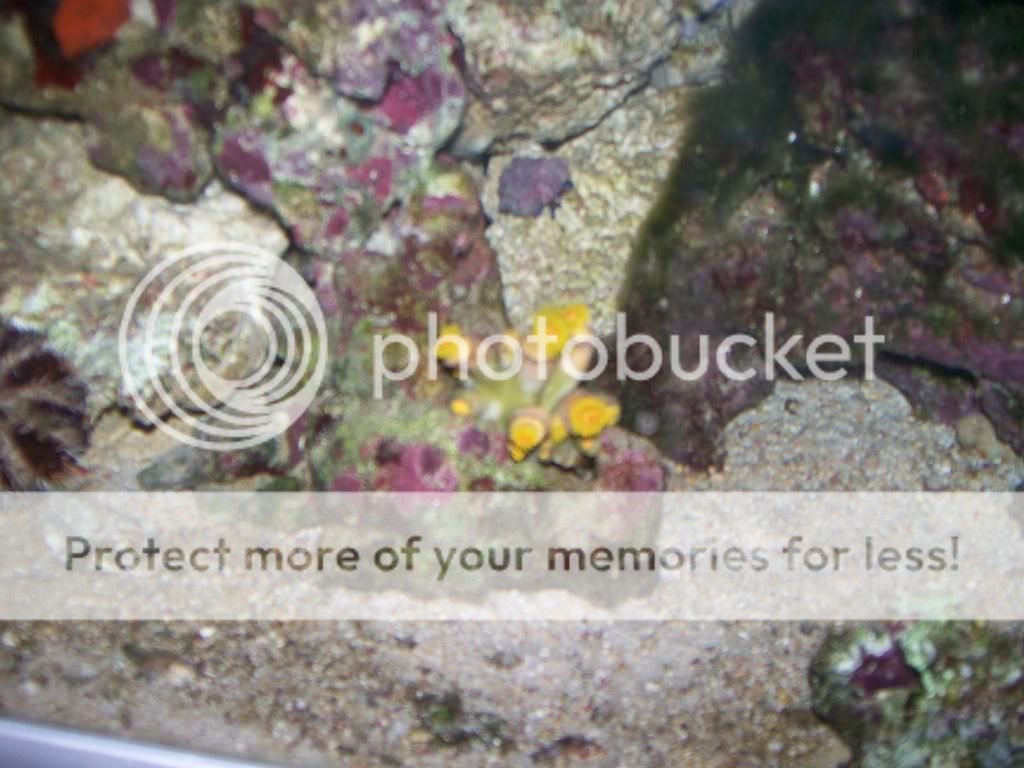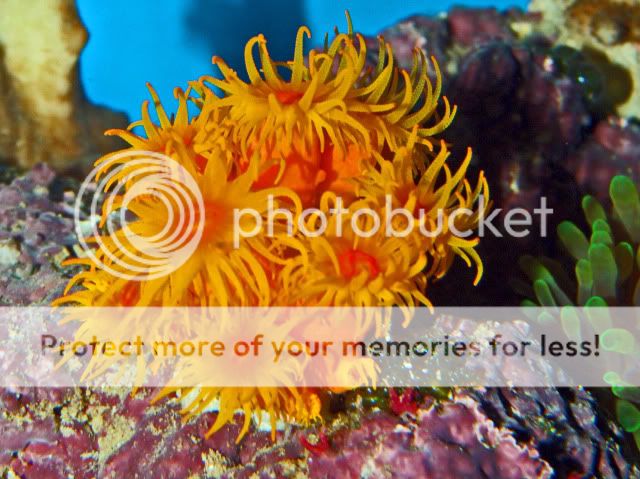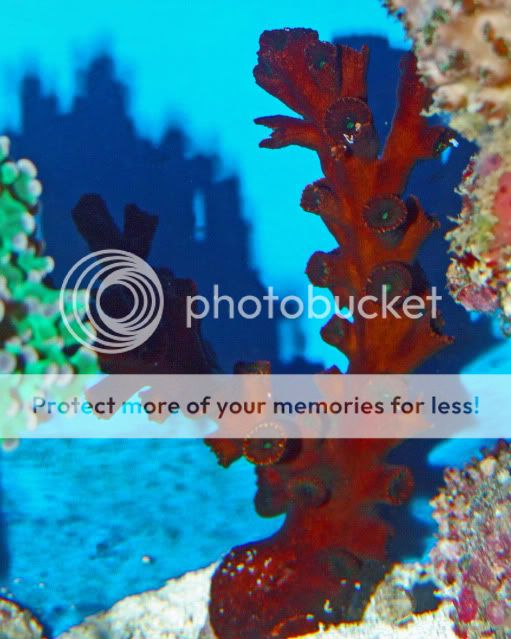seffieuk
I used to be indecisive but now I'm not so sure!
So, what does Eric Bourneman have to say about the lovely Sun Coral?
Family: Dendrophyliidae genus: Tubastrea common species: coccinea, aurea, micrantha, diaphena, faulkneri
common names: Sunflower, Sun, Orange Cup, Turret
Tubastrea is one of the most photographed corals in the world. This is not without reason. The brilliant orange coral issues forth lovely yellow orange tentacles at night, and is a sight that almost defies description. Many years ago when I first began keeping corals, this was one of my first purchases. It has always been readily available, and yet many people have a difficult time keeping it alive. The reason for this is that they are asymbiotic; that is, they do not possess zooxanthellae. This most intriguing aspect will be discussed after a brief description of the coral and its species.
The Sunflower corals are a broad category of corals which are not adequately described by their common name. Tubastrea faulkneri and T. coccinea are by far the most common species available within the hobby, and are easily recognized by their orange cups. The dendroid colonies are very lightweight and are ahermatypic, meaning they do not contribute significantly to reef structure. Tubular and very apparent corallites rise off a generally ball-like main skeletal body, and are covered with a skin-like orange coenosteum. Septa are prominent and obvious, especially in fully contracted specimens. The polyps are large and extend mostly at night, although well fed and/or trained polyps may emerge during the day as well, especially if food is present. These corals have thick and sharply tapered tentacles, with the nematocyst buds and batteries visible as opaque spots on the translucent yellow to orange tentacles. A prominent central mouth is apparent, and completes an overall polyp one that truly typifies the "textbook" polyp formation.
In nature, Tubastrea is found usually found upside down at the entrance to caves. It is occasionally found in the open reef, under overhangs, or in areas of high nutrients that can provide for the corals nutritive needs. It is this aspect which sets Tubastrea apart from many other aquarium corals. It does not have symbiotic algae in its tissue, and must therefore depend entirely on direct nutrient uptake from the water and from heterotrophic food capture...and this coral has an insatiable appetite. Capable of feeding on large zooplankton, captured food is rapidly engulfed with their polyps extended again as soon as the food is taken into the gastric cavity. Contrary to popular opinion, Tubastrea are not found under overhangs and in caves because they cannot tolerate light. Nor are they found there because they cannot compete with stony corals. Rather, cave waters and overhangs are areas far richer in terms of nutrients and plankton populations, and so these corals thrive in areas that can provide them with enough food supply. Furthermore, the highly porous skeleton is adept at storing phosphorous and nitrogen in its pore waters, which the corals can use as a "back-up supply" of these sometimes limited nutrients.
Tubastrea , despite its obviously competent feeding behavior, does not seem to pose a threat to neighboring corals in terms of its stinging capabilities. Any such behavior is also somewhat mollified in that the tentacles are usually extended at times when other corals are completely retracted.
In terms of aquarium care, specimens should be positioned in areas of consistent water flow that will bring them available food when expanded. Aquariums employing strong foam fractionation that rapidly remove any "reef snow" planktonic elements should take note of the following: the key to success with Tubastrea is regular feeding. These corals will usually recede and waste away, cup by cup, unless provided with regular food sources. Once Tubastrea begins to recede, hair algae can gain an easy foothold on the porous skeleton and cause further erosion of tissue. Feeding is best accomplished with the use of a syringe. I attach a piece of rigid airline tubing to reach all the individual polyps, and then carefully blow a cloud of food over the entire colony. I feed my colonies 5cc of frozen vitamin soaked food every other night. It is possible for these corals to exist on less food, especially if each polyps is carefully fed, yet a lack of food is not in the best interest of these corals. If kept "fat and happy," Tubastrea retains a swollen look to its polyps, the skeleton becomes somewhat obscured, and the polyp tissue and coenosteum adopts a more pastel shade of orange. Furthermore, healthy Tubastrea will soon begin to bud new polyps around the colony, many times releasing them to settle throughout the tank. Brine shrimp, mysis shrimp and other frozen preparations are all valuable food sources to the corals. Soaking foods in a vitamin supplement seems to enhance the ability of the corals to bud.
Many newly acquired specimens take some time before they begin to extend their tentacles to feed. In fact, they may often seem to refuse to open. Several diligent evenings of blowing food across the closed cups will usually entice a polyp to begin peeking out. Once started, there will rarely be occasion to have them not open in full glory in expectation of food. Most hobbyists who have difficulty keeping Tubastrea alive are simply not feeding it enough. Obviously, this continuous and somewhat excessive input of food may not be without consequence in terms of water quality. It is imperative that any tank housing colonies of Tubastrea be able or equipped to handle the extra nutrient load so as not to degrade the health of the tank and stimulate problem algaes.
Black sun coral, T. micrantha . is a unique species occasionally available in the hobby. It has a branching dendroid skeleton with fluorescent dark olive green to brownish black tissue and tentacles. It has a very poor record of survival in captivity, partly because of its care requirements. This coral is generally found in areas of extremely strong currents and very high plankton populations. Thus feeding is even more imperative for this coral, and the specific care requirements necessary for its health may be more than can be provided by the majority of reef keepers.
A final point of interest about these corals before concluding; the research that has been done on Tubastrea is quite prolific. It is, because of its relative abundance in the reef communities and asymbiotic nature, often used as a "placebo," of sorts, in quantifying baseline rates of calcification in symbiotic corals. It is the "incidental" coral, since its growth rate could be easily calculated in terms of its mass as being entirely unrelated to light induced growth. It seems, though, that this rate was not ever really established until recently, and was always assumed to be the same as that of symbiotic corals deprived of light or bleached of their zooxanthellae. In many studies, Tubastrea has been used to "prove" why corals containing zooxanthellae calcify so much faster than those without zooxanthellae, and to "prove" the reasons that zooxanthellate corals are evolutionarily superior, dominant, and the more important builders of reef communities. But, it now seems that much of the work involved in establishing the " Tubastrea " baseline was somewhat haphazard, because Tubastrea does actually calcify at a rate, in terms of mass gained, that is comparable to some of the fastest growing hermatypic symbiotic corals. The reason that it does not predominate or compete with symbiotic reef building corals is that its requirements and habitat are different and more specialized. Because of these requirements, it cannot, by its very nature be significantly hermatypic. Yet, it can no longer be thought that asymbiotic corals are less able to effectively grow and calcify than their algae containing counterparts. Interesting tidbit, in my opinion.
In conclusion, Tubastrea , the sunflower coral, is a wonderful addition to many reef tanks. It is hardy, though also demanding of certain basic needs which are no more or no less than many other corals. The most important consideration is that it be fed, and that the nutrient load is considered before attempting to keep these beautiful animals. With proper care, the glorious splash of brilliant orange and yellow is a most deserved reward and splendid sight for the hobbyist.
Eric Borneman
References:
Marshall, A.T. Calcification in Hermatypic and Ahermatypic Corals. Science 271: 637-9. February 2, 1996
Family: Dendrophyliidae genus: Tubastrea common species: coccinea, aurea, micrantha, diaphena, faulkneri
common names: Sunflower, Sun, Orange Cup, Turret
Tubastrea is one of the most photographed corals in the world. This is not without reason. The brilliant orange coral issues forth lovely yellow orange tentacles at night, and is a sight that almost defies description. Many years ago when I first began keeping corals, this was one of my first purchases. It has always been readily available, and yet many people have a difficult time keeping it alive. The reason for this is that they are asymbiotic; that is, they do not possess zooxanthellae. This most intriguing aspect will be discussed after a brief description of the coral and its species.
The Sunflower corals are a broad category of corals which are not adequately described by their common name. Tubastrea faulkneri and T. coccinea are by far the most common species available within the hobby, and are easily recognized by their orange cups. The dendroid colonies are very lightweight and are ahermatypic, meaning they do not contribute significantly to reef structure. Tubular and very apparent corallites rise off a generally ball-like main skeletal body, and are covered with a skin-like orange coenosteum. Septa are prominent and obvious, especially in fully contracted specimens. The polyps are large and extend mostly at night, although well fed and/or trained polyps may emerge during the day as well, especially if food is present. These corals have thick and sharply tapered tentacles, with the nematocyst buds and batteries visible as opaque spots on the translucent yellow to orange tentacles. A prominent central mouth is apparent, and completes an overall polyp one that truly typifies the "textbook" polyp formation.
In nature, Tubastrea is found usually found upside down at the entrance to caves. It is occasionally found in the open reef, under overhangs, or in areas of high nutrients that can provide for the corals nutritive needs. It is this aspect which sets Tubastrea apart from many other aquarium corals. It does not have symbiotic algae in its tissue, and must therefore depend entirely on direct nutrient uptake from the water and from heterotrophic food capture...and this coral has an insatiable appetite. Capable of feeding on large zooplankton, captured food is rapidly engulfed with their polyps extended again as soon as the food is taken into the gastric cavity. Contrary to popular opinion, Tubastrea are not found under overhangs and in caves because they cannot tolerate light. Nor are they found there because they cannot compete with stony corals. Rather, cave waters and overhangs are areas far richer in terms of nutrients and plankton populations, and so these corals thrive in areas that can provide them with enough food supply. Furthermore, the highly porous skeleton is adept at storing phosphorous and nitrogen in its pore waters, which the corals can use as a "back-up supply" of these sometimes limited nutrients.
Tubastrea , despite its obviously competent feeding behavior, does not seem to pose a threat to neighboring corals in terms of its stinging capabilities. Any such behavior is also somewhat mollified in that the tentacles are usually extended at times when other corals are completely retracted.
In terms of aquarium care, specimens should be positioned in areas of consistent water flow that will bring them available food when expanded. Aquariums employing strong foam fractionation that rapidly remove any "reef snow" planktonic elements should take note of the following: the key to success with Tubastrea is regular feeding. These corals will usually recede and waste away, cup by cup, unless provided with regular food sources. Once Tubastrea begins to recede, hair algae can gain an easy foothold on the porous skeleton and cause further erosion of tissue. Feeding is best accomplished with the use of a syringe. I attach a piece of rigid airline tubing to reach all the individual polyps, and then carefully blow a cloud of food over the entire colony. I feed my colonies 5cc of frozen vitamin soaked food every other night. It is possible for these corals to exist on less food, especially if each polyps is carefully fed, yet a lack of food is not in the best interest of these corals. If kept "fat and happy," Tubastrea retains a swollen look to its polyps, the skeleton becomes somewhat obscured, and the polyp tissue and coenosteum adopts a more pastel shade of orange. Furthermore, healthy Tubastrea will soon begin to bud new polyps around the colony, many times releasing them to settle throughout the tank. Brine shrimp, mysis shrimp and other frozen preparations are all valuable food sources to the corals. Soaking foods in a vitamin supplement seems to enhance the ability of the corals to bud.
Many newly acquired specimens take some time before they begin to extend their tentacles to feed. In fact, they may often seem to refuse to open. Several diligent evenings of blowing food across the closed cups will usually entice a polyp to begin peeking out. Once started, there will rarely be occasion to have them not open in full glory in expectation of food. Most hobbyists who have difficulty keeping Tubastrea alive are simply not feeding it enough. Obviously, this continuous and somewhat excessive input of food may not be without consequence in terms of water quality. It is imperative that any tank housing colonies of Tubastrea be able or equipped to handle the extra nutrient load so as not to degrade the health of the tank and stimulate problem algaes.
Black sun coral, T. micrantha . is a unique species occasionally available in the hobby. It has a branching dendroid skeleton with fluorescent dark olive green to brownish black tissue and tentacles. It has a very poor record of survival in captivity, partly because of its care requirements. This coral is generally found in areas of extremely strong currents and very high plankton populations. Thus feeding is even more imperative for this coral, and the specific care requirements necessary for its health may be more than can be provided by the majority of reef keepers.
A final point of interest about these corals before concluding; the research that has been done on Tubastrea is quite prolific. It is, because of its relative abundance in the reef communities and asymbiotic nature, often used as a "placebo," of sorts, in quantifying baseline rates of calcification in symbiotic corals. It is the "incidental" coral, since its growth rate could be easily calculated in terms of its mass as being entirely unrelated to light induced growth. It seems, though, that this rate was not ever really established until recently, and was always assumed to be the same as that of symbiotic corals deprived of light or bleached of their zooxanthellae. In many studies, Tubastrea has been used to "prove" why corals containing zooxanthellae calcify so much faster than those without zooxanthellae, and to "prove" the reasons that zooxanthellate corals are evolutionarily superior, dominant, and the more important builders of reef communities. But, it now seems that much of the work involved in establishing the " Tubastrea " baseline was somewhat haphazard, because Tubastrea does actually calcify at a rate, in terms of mass gained, that is comparable to some of the fastest growing hermatypic symbiotic corals. The reason that it does not predominate or compete with symbiotic reef building corals is that its requirements and habitat are different and more specialized. Because of these requirements, it cannot, by its very nature be significantly hermatypic. Yet, it can no longer be thought that asymbiotic corals are less able to effectively grow and calcify than their algae containing counterparts. Interesting tidbit, in my opinion.
In conclusion, Tubastrea , the sunflower coral, is a wonderful addition to many reef tanks. It is hardy, though also demanding of certain basic needs which are no more or no less than many other corals. The most important consideration is that it be fed, and that the nutrient load is considered before attempting to keep these beautiful animals. With proper care, the glorious splash of brilliant orange and yellow is a most deserved reward and splendid sight for the hobbyist.
Eric Borneman
References:
Marshall, A.T. Calcification in Hermatypic and Ahermatypic Corals. Science 271: 637-9. February 2, 1996








